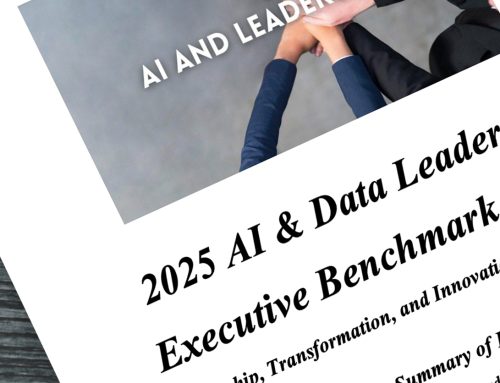Will your organization rise to the challenge—or fall behind?
With AI shaking up entire industries, economic pressures forcing businesses to do more with less, and the relentless complexity of multi-cloud environments, data leaders are at a crossroads.
The stakes have never been higher. Companies that harness these trends will unlock unprecedented opportunities for innovation and efficiency. Those that don’t risk being left in the dust. This article isn’t just another list of buzzwords—it’s a guide to the real changes reshaping data management and actionable advice to help you capitalize on them.
So, what’s next for data management? We polled Ataccama’s data gurus and some of our Board advisors to get their take.

There will be a shift from ‘Death by Dashboards’ to ‘Conversations with data’
From static dashboards to realtime conversations
In 2025, we will start to see business intelligence and analytics tools shift from overwhelming, static dashboards to enabling dynamic, real-time “conversations with data”.
Organizations will embrace AI-powered platforms that allow users to ask natural language questions and receive contextual insights, trends, and actionable recommendations instantly. This evolution will democratize data access, reduce decision fatigue, and make analytics more intuitive and impactful for all stakeholders.
Conversational analytics will make data feel less like a static tool for analysis and more like a dynamic collaborator, reshaping how organizations of all sizes leverage insights for growth and innovation.
Tips:
- Invest in AI-driven tools with natural language capabilities. Focusing on tools that integrate with your existing data ecosystem and provide access to real-time information will empower non-technical users to extract value from data.
- Prioritize data quality and governance. Clean, accurate, and well-organized data is the foundation for reliable AI-driven analytics.
- Nurture a culture of data literacy. Democratizing data will reduce reliance on specialists, empower faster decision-making, and nurture a data-first mindset across the organization.
- Use AI for proactive recommendations and to identify trends. This can drive smarter, more confident decision-making at all levels of the organization.
By aligning these strategies with the shift toward conversational data analytics, companies can make smarter, faster, and more impactful decisions while enabling a truly data-driven culture.

Data and AI leadership roles will evolve to include responsibility for strategic business and customer use cases.
AI leadership roles will be in greater demand than ever
With AI initiatives now landing squarely on the desks of CDOs, they’re no longer just the keepers of data governance. It’s an enormous opportunity for them to redefine their roles, make a tangible impact, and fuel innovation within their organizations.
This means data and AI leadership roles will be in greater demand than ever. According to the 2025 AI & Data Leadership Executive Benchmark Survey, 84.3% of Fortune 1000 and leading global organizations have now appointed a Chief Data Officer (CDO/CDAO), up from just 12% in 2012, and 33.1% have appointed a Chief AI Officer (CAIO), or the equivalent.
AI is a game-changer, shifting the focus to offensive use cases like driving revenue, improving customer experiences, and unlocking entirely new business models. Massive interest in AI is fueling investment in data, with the understanding that AI is only as good as the data that is available to it. The 2025 survey highlights that 98.4% of organizations report increased investment in AI, with 93.7% reporting that interest in AI is leading to a greater focus on data.
But CDOs don’t have to reinvent the wheel – the secret to winning at AI starts with trust in your data. No matter how advanced your AI models are, if the underlying data isn’t accurate and reliable, those efforts will fail.
Tips:
- Focus on data quality first. A data catalog won’t cut it for offensive use cases. Start by building trust in your data to lay the groundwork for innovation.
- Aim for quick wins. Think big, but also tackle lower-hanging fruit to show value early and gain momentum.
- Tap into your network. Ask your peers for advice and inspiration—they’ve likely faced similar challenges.
- Listen to your team. The best ideas often come from within your organization, but they’re sometimes overlooked.
By balancing bold ambitions with smart, actionable steps, data and AI leaders can seize this moment to emerge as key drivers of innovation and success.

Investment in generative AI will move from experimentation to customer-impacting outcomes
AI: from experiments to significant impact
Organizations will start to invest in building the foundational capabilities that are necessary to drive more value-driven use cases around actionable insights.
Recent advancements in data and technology are exciting and have the potential of reshaping how businesses operate, the experience they are able to offer to their customers, and lower their operational expense. However, the key to leveraging these advanced approaches requires a stable and trusted foundation, which more organizations will begin to focus on this year.
There will also be a shift in investment in generative AI across organizations as they move from experimentation to customer-impacting outcomes. A number of organizations have spent the last 18-24 months experimenting with generative and will now start to narrow down the specific areas in which this technology can make a significant impact.
Adoption of these tools and products across the organization will be key to success which will require a lot more collaboration between data and other functions across the organization.
Tips:
- Focus on foundational capabilities. Invest in robust data quality, governance, and management capabilities to build a strong data foundation that ensures your data is trusted and accessible. Without this stable foundation, advanced technologies like generative AI and actionable insights will struggle to deliver reliable outcomes.
- Identify high-impact use cases. Move beyond experimentation by pinpointing areas where generative AI and actionable insights can create significant value—whether through enhanced customer experiences, operational efficiencies, or innovative products. Target investments to where they will make the most tangible impact.
- Foster collaboration across functions. Break down silos between data teams and business units to ensure organization-wide adoption of these tools. Collaborative workflows and shared goals will be essential to turning insights into actions that benefit the entire business.

Meet federated governance provides the perfect balance: a centralised team sets up the technology base while data experts manage domain-specific needs.
Data Governance: from chaos to collaboration
For years, companies struggled to find the right data governance model. First, centralization seemed like the answer: one team to fix all data issues. But this quickly failed—without business context, the central team became a bottleneck. Then came decentralization, giving business teams full control over their data. While this solved some problems, it created new ones, like auditability headaches, duplicated efforts, and skyrocketing costs.
Enter federated governance, the “Goldilocks” solution. It strikes the perfect balance: a centralized team sets up the technology foundation, processes, and guardrails, while business teams retain their own data experts to manage domain-specific needs. This collaboration—structured but flexible—ensures that governance efforts are scalable, auditable, and still deeply connected to the business.
But make no mistake: federated governance isn’t just a tool or a tech fix—it’s a people-first approach. It requires strong communication, clear roles, and alignment across the entire organization to work effectively.
Tips:
- It is about people, not tools. Federated governance is 80% about people and processes and only 20% about software. Speak with stakeholders to co-create an environment that actually works for everyone.
- Get executive buy-in. Proper data management starts at the top. Ensure your executive team is aligned, understands its importance, and is ready to support it—even if that means more work for their teams.
- Find your ambassadors. There are people in your organization who love data as much as you do. Identify them, empower them, and let them advocate for governance within their business units.
- Prioritize data literacy. Equip teams with the training they need to work effectively with data. Adoption depends on people knowing how to use the tools and follow the processes you establish.
Federated governance isn’t about choosing between centralization or decentralization—it’s about taking the best of both worlds and building something that works. Done right, it creates a governance model that’s efficient, collaborative, and sustainable.

Data Quality is no longer a behind-the-scenes hygiene task; it’s foundational to driving innovation, creating value, and staying competitive.
Data quality: from defensive necessity to strategic enabler
It might feel strange to call data quality a “trend” in 2025, but for years, the focus was on defensive use cases like governing, documenting, and protecting data. The more mature organizations added monitoring, using dashboards to expose just how bad their data quality was. Then came the handoff: pointing fingers at source system owners to “fix their data.” But that approach doesn’t cut it anymore.
It’s time to fix the problem, not just measure it, and this shift is putting data quality squarely in the spotlight. It’s no longer a behind-the-scenes hygiene task; it’s foundational to driving innovation, creating value, and staying competitive. Companies are realizing how important it is to have trust in data and that prioritizing data quality solutions is an investment in their future by enabling innovation, improving decision-making, and delivering business impact.
Tips:
- Start small but impactful. Measure data quality for your most important domains first and use data lineage to identify the most used and impactful assets to help you get started. Work with the business to define meaningful quality metrics and set up transparent monitoring.
- Scale with observability. Full-scale quality monitoring isn’t practical for all assets. Use data observability tools to detect anomalies across your entire data ecosystem.
- Fix, don’t just measure. Invest in a solution that can clean and standardize your data. Look for tools that are technology-agnostic so you can apply fixes across your entire landscape.
By shifting from simply measuring quality to actively improving it, you’ll unlock the full potential of your data. In a world that increasingly relies on AI and business use cases, this isn’t just important—it’s non-negotiable.

2025 will be the year in which enterprises weigh its long-term potential against its short-term impact, and chart a path forward.
Beyond 2025: A pivotal year for assessing the value of agentic AI
Agentic AI is the future of data management and governance. With the potential to revolutionize how organizations manage and govern their data, the adoption of autonomous AI systems will deliver highly sophisticated capabilities from automating repetitive tasks to managing complex workflows.
As exciting as it sounds, 2025 will be the year in which enterprises weigh its long-term potential against its short-term impact, and chart a path forward.
While some vendors have begun releasing early agentic AI capabilities, this technology won’t become available—or mature enough – for most organizations to drive real change until a few years down the line. The first iterations we see in the market will likely be experimental with limited practical application, and are worth keeping an eye on if you are planning to include agentic AI in your future data strategy.
Tips:
- Engage your vendors. Have conversations with your current data management and governance providers to learn if and when Agentic AI is on their roadmap. A lack of plans could signal they’re falling behind.
- Stay ahead of the curve. Explore innovative tools that are likely to lead the market by 2027+ to ensure your organization isn’t left behind when Agentic AI takes off. The groundwork you lay today will determine how ready you are to adopt Agentic AI when it becomes viable.
Conclusion
These trends represent the evolving priorities in data management for 2025: driving business value, improving operational efficiency, and building smarter, more scalable systems. While navigating these changes can feel daunting, the opportunities for innovation and impact are immense.
The key takeaway? Don’t get overwhelmed. Focus on what matters most to your organization, whether it’s improving data quality, streamlining costs, or setting up a governance model that works. Take deliberate, strategic steps—and don’t forget to think ahead. Trends like Agentic AI may not dominate in 2025, but preparing for what’s next will position you for long-term success.
Data management is no longer just about keeping up—it’s about staying ahead. The companies that succeed will be the ones that embrace these trends thoughtfully and use them to create real business value.




